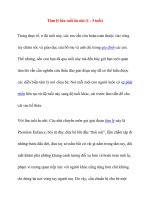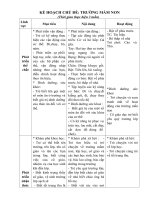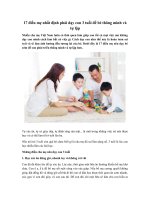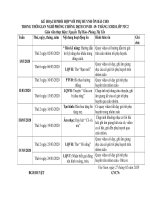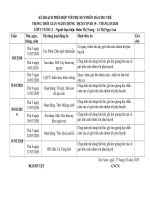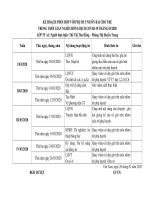Một số đặc điểm dịch tễ học, yếu tố nguy cơ gây nghe kém tiếp nhận và hiệu quả can thiệp đeo máy trợ thính ở trẻ em dưới 3 tuổi tại Bệnh viện Nhi Trung ương tt
Bạn đang xem bản rút gọn của tài liệu. Xem và tải ngay bản đầy đủ của tài liệu tại đây (372.58 KB, 27 trang )
MINISTRY OF EDUCATION
MINISTRY OF HEALTH
AND TRAINING
NATIONAL INSTITUTE OF HYGIENE AND EPIDEMIOLOGY
---------
LẠI THU HÀ
SOME EPIDEMIOLOGICAL CHARACTERISTICS, RISK
FACTORS OF SENSORINEURAL HEARING LOSS AND
EFFECTIVENESS OF HEARING AID ON CHILDREN
UNDER 3 YEARS OLD AT THE NATIONAL CHILDREN
HOSPITAL
Track: Epidemiology
Code: 62 72 01 17
DOCTOR OF PHYSOLOPHY THESIS SUMMARY
HÀ NỘI – 2022
THE THESIS WAS COMPLETED AT THE NATIONAL
INSTITUTE OF HYGIENE AND EPIDEMIOLOGY
Supervisors:
1. Assoc.Prof. Vu Dinh Thiem , PhD
2. PhD. Phan Huu Phuc
Reviewer 1:
………………………………………………………………………
Reviewer 2:
………………………………………………………………………
Reviewer 3:
………………………………………………………………………
The thesis will be (was) defensed before the Institute level - thesis
Evaluation Committee at the National Institute of Hygiene and
Epidemiology at …… (time), …/…/…… (date)
LIST OF PUBLISHED ARTICLES RELATED
TO THE THESIS
1. Lai Thu Ha, Vu Dinh Thiem, Phan Huu Phuc (2020), “Risk
factors in children with hearing loss under 3 years old at the
Audiology and Speech langugage Therapy centre at National
Children Hospital in 2018-2019” , Journal of Medicine and
Pharmacy, No. 4, pp. 109-111.
2. Lai Thu Ha, Vu Dinh Thiem, Phan Huu Phuc (2021),
"Evaluating the effectiveness of hearing aids for children
with hearing loss under 3 years old at the National Children
Hospital in 2018-2019", Journal of Community Medicine,
No 6.
3.
Vu Dinh Thiem, Lai Thu Ha, Phan Huu Phuc (2021), "Some
epidemiological characteristics of children with hearing loss
under 3 years old at the National Children Hospital in 20182019", Journal of Community Medicine , No 6.
1
INTRODUCTION
According to the
National
Academy of
Hearing and
Communication Diseases of America, hearing loss is the most
common congenital abnormality in young children. Every year in the
United States, about 12,000 newborn babies with hearing loss are
diagnosed. In addition, approximately 4,000 to 6,000 children aged
0-3 years are found to have hearing loss even though these children
pass the newborn hearing screening test. A total of 16,000 - 18,000
babies and infants are detected with hearing loss each year. Hearing
loss in children causes serious consequences on children's language
development, communication and learning. With the development of
science and technology, children with hearing loss will have normal
hearing after intervention, but late detection and intervention greatly
affect the success of treatment. In Vietnam, there is no newborn
hearing screening program, “risk factors for hearing loss” is a
relatively new concept for most pediatricians, and the goverment
does not provide support for interventions. Therefore, children with
hearing loss in our country are often diagnosed late, the intervention
is not thorough, leading to a very low rate of hearing loss children
having been successfully intervened.
To provide some epidemiological characteristics of children
with hearing loss under 3 years of age, risk factors and the
effectiveness of hearing aids in children with hearing loss, thereby
build up hearing monitoring procedures and hearing aid wearing
recommendations for children with hearing loss, this research is
conducted.
2
OBJECTIVES OF THE STUDY
Objective 1: Describe some epidemiological characteristics of
sensorineural hearing loss in children under 3 years old at the
Audiology and speech language therapy centre in the National
Children Hospital in 2018-2019.
Objective 2: Identify risk factors for sensorineural hearing loss
in children under 3 years of age.
Objective 3: Evaluate the effectiveness of hearing aid
interventions to improve hearing in sensorineural hearing loss
children under 3 years old.
NEW SCIENTIFIC POINTS AND PRACTICAL VALUES OF
THE TOPIC
Currently, there are not many studies on the situation of hearing
loss in children, especially in children under 3 years old.
This study has identified some risk factors for hearing loss in
children, thereby helping to build up hearing monitoring procedures
for children with these risk factors. This will help detect hearing loss
in children as soon as possible, setting prerequisites for successful
interventions on children.
The study has also evaluated the effectiveness of hearing aid
interventions on children with hearing loss, thereby knowing which
degree of hearing loss that benefits well from the hearing aids. This
helps clinicians have the right direction when prescribing treatment
for children with hearing loss.
STRUCTURE OF THE THESIS
The thesis consists of 100 pages, excluding references and
appendices, with 27 tables, 19 figures and 12 charts. Introduction (2
pages), overview (34 pages), methodology (17 pages), results (24
pages), discussion (20 pages), conclusion (2 pages) and
recommendations (1 page).
3
Chapter 1. OVERVIEW
1.1 The situation of children with hearing loss in the world and in
Viet Nam
Worldwide: In 1995, WHO estimated that 120 million people
have permanent binaural hearing loss (>40 dB HL) globally. In 2005
the number was doubled to 278 million. By 2018, there were about
466 million people with hearing loss in the world, accounting for
over 6.1% of the world's population. Of these, 432 million were
adults (93%) and 34 million were children, accounting for about 7%.
Figure 1.1. Rate of hearing loss of children (0-15 years old) in regions
The importance of hearing loss in children is reflected in the
following facts:
Hearing loss is the most common birth defect in the United States
- There are 2-5 children out of every 1000 children were born with
permanent severe congenital hearing loss in both ears
- 3 more children of these 1000 children will get acquired hearing
loss during the first years of life or school age
- Everyday, 33 babies (12,000 children/year) are born in the US with
permanent hearing loss
4
- Children who spend time in the neonatal intensive care unit
(NICU) fall are in the group of high-risk for hearing loss, with at least one
in 50 children get severe hearing loss.
- Some children are born with normal hearing, but there are many
causes for progressive hearing loss when children start primary school.
- Research shows that 90% of young children's understanding comes
from unintentionally listening to what's going on around them, so learning
will be hindered when children have hearing loss even mild hearing loss.
- 17/1000 children under 18 years old have hearing loss
- Today, the number of children with severe and profound hearing
loss is less than a half of what it was in the past, but the number of children
with mild to moderate hearing loss has increased tenfold.
- Otitis media is the most common infection in children and the
leading cause of hearing loss in young children.
- Nearly every child has periods of hearing loss related to otitis media
from birth until they are 10 years old.
- 10-15% of children do not pass the school hearing screening test
In Viet Nam
There is very few research on this issue. Most research uses sensory
instruments or screening tests. In 2001, author Le Thi Lan and her
colleagues conducted a study about auditory responses on 900 high-risk
infants at the hospital for Mother and Child Protection with handmade
bells. The results showed that the rate of non-response to sound in this
group was 4.4%. Author Pham Thi Coi and colleagues used cochlear
sound assessment to assess hearing for 823 children under 5 years old in
Bac Ninh, Thai Nguyen, Phu Tho, showing that 4.87% of children
suspected of having hearing loss. Author Pham Thu Thuy used OAE (oto
aucoustic emission) to assess hearing for 12202 newborns at the Hanoi
5
Obstetrics and Gynecology Hospital, the results showed that 3.4% of
babies did not pass this screening test.
For children with risk factors, there are also very few studies, in the
study of author Le Thu Ha in 2011 on 305 children with high risk factors
at the neonatal department in National Children Hospital, it was shown
that the rate of hearing loss in this group was 15%.
1.2. Hearing loss
1.2.1. Definition of hearing loss
Hearing loss is a total or partial loss or impairment of hearing that
prevents a child from hearing at normal distances and intensities of
sounds. Hearing loss has sensorineural hearing loss, conductive hearing
loss, and mixed hearing loss. Sensorineural hearing loss includes hearing
loss in the cochlea and behind the cochlea. Hearing loss at the cochlea is
caused by damage to the hair cells of the cochlea, hearing loss behind the
cochlea is damage to the auditory nerve. This is permanent hearing loss
which is not treatable with medication, acupuncture, or acupressure.
1.2.2. Degrees of hearing loss
According to ASHA (2010), we have
Normal hearing: hearing threshold is better than or equal to 15 db
Very mild hearing loss: 16-25 dB
Mild hearing loss: 20 - 40dB
Moderate hearing loss: 41-55dB
Severe moderate hearing loss: 56-70 dB
Severe hearing loss: 71-90 dB
Profound hearing loss >= 91 dB
1.3. High risk factors for hearing loss
In 1982, the JCIH – Joint Committee Infant Hearing recommended 7
groups of children who are at risk of hearing loss. In 1990, the risk factor
6
classification was expanded and recommendations were made for the
identification and management of children with hearing loss. Accordingly,
children with the following risk factors should be screened for hearing
problems:
* Newborn (under 28 days old).
Risk factors identified in the neonate include:
- Having family member with congenital or progressive hearing loss
- Infections during pregnancy, diseases that are associated with
hearing loss such as: toxoplasmosis, rubella, CMV, herpes, syphilis.
- Craniofacial abnormalities include morphological abnormalities of
the auricle, ear canal, low hairline..
- Birth weight less than 1500g.
- High bilirubin level requiring blood transfusion.
- Taking antibiotics of aminoglycosis group for more than 5 days
(gentamycin, tobramycin, kanamycin, streptomycin) and taking diuretics
in combination with aminoglycosis group.
- Meningitis.
- Very weak at birth, which may include infants who have Apgar
score of 0-3 in 5 minutes or those who do not breathe on their own in 10
minutes.
- Children on mechanical ventilation in 10 days or more.
- Signs or symptoms associated with syndromes which have
sensorineural hearing loss, such as Waardenburg or Usher.
* Risk factors for children from 29 days to 2 years old.
Risk factors for hearing loss include:
- Parents or caregivers of the children have problems of hearing,
speech, language or developmental delays.
- Meningitis.
7
- Risk factors from infancy which are associated with
sensorineural hearing loss (CMV, prolonged mechanical ventilation
and genetic diseases).
- Head trauma, especially with longitudinal and transverse
temporal fractures.
- Signs or symptoms associated with hearing impairment
syndromes such as Waardenburg or Usher syndrome.
- Taking antibiotics of aminoglycosis group more than 5 days
(gentamycin, tobramycin, kanamycin, streptomycin) and taking
diuretics in combination with aminoglycosis group.
-
Children
with
neurodegenerative
diseases
such
as
neurofibromatosis, epilepsy, Friedreich's ataxia, Huntington's chorea,
Werding-Hoffmann, Charcot-Marie-Tooth.
- Children with infections that cause hearing loss, such as
mumps and measles.
1.4. Intervention for children with receptive hearing loss
Today, with the development of science and technology, the
level of hearing loss is no longer a barrier. Regardless of the level of
hearing loss the child get, there are hearing technologies to help them
have normal hearing. This is very meaningful for children, their
families and the society. There are 2 technologies which are hearing
aids and cochlear implant. Hearing aids are suitable for children with
mild to severe hearing loss, cochlear implant is used for children with
severe to profound hearing loss. However, for children’s language
development, after interventions with hearing aids or cochlear
implant, children need speech therapy. In addition, the age at
intervention is very important because the brain prioritizes language
development in the first years of life.
8
CHAPTER 2: RESEARCH METHODOLOGY
2.1. Research sites:
Audiology and Speech language Therapy centre- National
Children Hospital.
2.2. Research duration: From January 2018 to August 2019.
2.3. Research subjects
2.3.1. Objective 1: Children aged 0-36 months who were diagnosed
with sensorineural hearing loss in the
Audiology and Speech
language therapy centre - National Children Hospital from January
2018 to August 2019.
2.3.2. Objective 2. There are 2 groups of study subjects.
- Disease group: These are children selected for objective 1 but
randomly selected.
- The control group: Children aged 0-36 months who came to
be vaccinated at the National Children Hospital and children in the
Hearing screening program in Hai Ba Trung district (Hanoi) who
passed the hearing screening test.
2.3.3. Objective 3: Children received hearing aids intervention at the
Audiology and Speech language therapy center (National Children
Hospital) from January 2018 to August 2019.
2.4. Research methodology
2.4.1. Objective 1
Reserch design: A cross-sectional descriptive study based on a
group population of children with hearing loss aged 0-36 months,
diagnosed with receptive hearing loss.
Sample size: 461 children diagnosed with hearing loss were
received by at the Central Children's Hospital's audiology center from
1/2018 to 8/2019.
9
2.4.2. Objective 2.
- Study design: A case-control study to determine risk factors
for hearing loss in children, designed in a 1:1 ratio.
- Sampling method: Random
- Formula to calculate sample size:
In there:
n: Minimum sample size
r: Ratio of sample size between the 2 groups, because the
control group and the disease group were designed in a 1:1 ratio, so r
=1
p: The rate of exposure to risk factors of the control group, with
the neonatal resuscitation rate in Vietnam being 7%, we have p=0.07
C = (zα/2 + zβ/2)2
α is a type 1 error, take α = 0.01
β is type 2 error, take β = 0.05
We have C=19.84
OR=10
Substituting the numbers in,we have n = 230 for both control
and disease groups. In this study, n = 570 (each group is 285)
2.4.3. Objective 3.
- Study design: Self-control intervention.
- Study sample size: Children who have been wearing hearing
aids from January 2018 to August 2019. Because the study evaluates
the effectiveness of hearing aids, it will evaluate each ear, so the
sample size t is 71 ears.
10
2.5. Data management and analysis
The information was collected based on homogeneous research
samples. Data were entered and processed by Epi data 3.0 software
and stata software 2.6.
Ethical aspects of research. The research protocol was approved
by the Scientific Council, the Ethical Council of the National Chidren
Hospital and the National Institute of Hygiene according to the
certificate No. 1297/BVNTW-VNCSKTE .
11
Chapter 3. RESULTS
3.1. Some epidemiological characteristics of hearing loss in
children under 3 years old at the National Children's Hospital.
3.1.1.Gender
Table 3.1. Prevalence of hearing loss by gender
Gender
N
%
Male
281
61
Female
180
39
Total
461
100
From January 2018 to August 2019, 461 children under 3 years
old were diagnosed with hearing loss at the Audiology and Speech
language therapy centre. In which, there are 281 boys, accounting for
61% and 180 girls, accounting for 39%.
3.1.2. Newborn hearing screening
Table 3.2. Neonatal screening rate Screening newborn hearing
Newborn hearing screening
N
%
Yes
No
48
410
10,4
88,9
Don’t know
Total
3
461
0,7
100
Out of 461 children with hearing loss, only 48 children were
screened by newborn hearing screening, accounting for 10.4%, and
410 children were not screened, accounting for 88.9%. There were 3
children of which whose parents did not know if they had done
newborn hearing screening for their child.
12
3.1.2. Age of hearing loss detection
Chart 3.1. Rate of hearing loss by age of detection
The most commonly detected age of hearing loss is 13 -24
months group (153 children - 33%), followed by 25-36 months (123
children - 26.7%), thirdly is 0-6 months (112 children -24.3%).
3.1.3. Unitarelal and bilataral hearing loss
Chart 3.2. Unitarelal and bilataral hearing loss
There were 44 unilateral children with hearing loss, accounting
for 9.5%, of which there were 19 cases of hearing loss in the right ear
and 25 cases of hearing loss in the left ear. Bilateral hearing loss are
417 children, accounting for 90.5%.
13
3.1.4. Degrees of hearing loss:
Figure 3.3. Degrees of hearing loss
Hearing loss at profound degree accounted for the highest rate
with 269 children (58.4%), ranking second was severe hearing loss
with 55 children accounting for 11.9%, third place was moderately
severe hearing loss with 32 children (6.9%). Retro-cochlear hearing
loss (ANSD) had 77 children which accounted for 16.7%.
14
3.1.7. The current status of interventions for children with hearing loss
Figure 3.4. Intervention on children with hearing loss
Among 461 children with hearing loss, 122 children received
intervention, accounting for 26%, or less than 1/3 of the number of
children with hearing loss, of which 81 children were wearing
hearing aids, accounting for 17.6%. The number of children receiving
cochlear implantation was 41, accounting for 8.9%.
3.1.8. Intervention by wearing hearing aids
Figure 3.5. Wearing hearing aids intervention
Among 81 childen who received intervention by wearing
hearing aids, there were 25 children wearing a single-sided hearing
aid, accounting for 30.9%, and there were 56 children wearing
binaural hearing aids, accounting for 69.1%
15
3.1.10. The average intervention period by age group
Table 3.5. The average intervention period by age group
The average intervention period
(months)
Age of diagnosis
N
Media
IQR
Under 6 months old
12
6.9
1.8
12.6
6-12 months old
17
2.8
0.7
9.1
13-24 months old
37
3.4
1
6.5
25-36 months old
34
2.5
0.75
8.3
The intervention period on children from 25-36 months old was
the fastest (2.5 months), ranking second was the intervention period
on the age group of 6-12 months old (2.8 months), followed by the
group of children aged 13 – 24 months (3.4 months). The longest
intervention period was the one for children aged under 6 months old
(6.9 months).
3.2.2. Analysis of risk factors for hearing loss by multivariable
regression
Table 3.8. The relationship between factors and hearing loss – the
multivariable regression model
Factors
OR correction
95% CI
Male
Low birth weight
1.5
1.5
1.1-2.2
0.7-3.1
Premature birth
Jaundice after birth
Asphyxia after birth
Mechanical ventilation
Having family member with early
hearing loss history
Neonatal resuscitation
1.4
0.9
3.8
2.7
20.5
0.7-2.8
0.5-1.6
1.2-12.2
0.9-8.8
4.8-88.5
4.0
1.8-8.9
16
Boys have a 1.5 times higher risk of hearing loss than girls
(OR=1.5 [1.1-2,2]). Children with asphyxia after birth have a risk of
hearing loss 3.8 times higher than normal children (OR=3.8 [1,212,2]). Children with a history of neonatal resuscitation have a 4
times higher risk of hearing loss than normal children (OR=4.0 [1.88.9]). Children in families with people with early hearing loss have a
20.5 times higher risk of hearing loss than other children (OR=20.5
[4.8-88.5].
3.2.3.2. Analysis of risk factors for hearing loss behind the cochlea
(ANSD) by multivariable regression
Table 3.10. The relationship between the factors and ANSD
according to the multivariable regression model
Factor
OR correction
95%CI
Male
2.4
0.9-6.1
Premature birth
3.6
1.1-11.5
Low birth weight - under 2500 gr
0.8
0.2-2.8
9
3.8-21.4
3.3
1.01-10.8
Jaundice after birth
Neonatal resuscitation history
Premature infants had a 3.6 times higher risk of developing
ANSD than full-term infants (OR=3.6 [1.1-11.5]). Infants with
neonatal jaundice were 9 times more likely to develop ANSD than
infants without neonatal jaundice (OR=9 [3,8-21,1]). Children with a
history of neonatal resuscitation had a 3.3 times higher risk of ANSD
than children without this history (OR=3.3 [1.01-10.8]).
17
3.3. Evaluation of the effectiveness after intervention by wearing
hearing aids
3.3.1. Average hearing improvement after wearing hearing aids
Table 3.11. Average hearing improvement after wearing hearing
aids
Improvement
Average
Min Max
± SD
Average hearing threshold
49.2 ± 9.5
23.3
66.7
(PTA)
Hearing
500Hz
47.5 ± 10.9
15
70
threshold in
1000Hz
49.9 ± 105
15
65
frequency
2000Hz
50.2 ± 10.1
29
70
ranges (PTA)
4000Hz
47.9 ± 10.2
20
70
SII (%)
38.5 ± 27.4
0
97
Maximum word comprehension
60.9 ± 38.5
0
100
(%)
Maximum sentence
73.0 ± 34.2
0
100
comprehension (%)
The average improvement in hearing threshold in 71 hearing loss ears
after wearing hearing aids was 49.2 ± 9.5. In which the improvement
at 500 Hz was 47.5 ± 10.9; frequency 1000 was 49.9 ± 10.5;
frequency 2000 Hz was 50.2 ± 10.1; frequency 4000 Hz was 47.9 ±
10.2. SII improved 38.5 ± 27.4%. Maximum word comprehension
improved 60.9 ± 38.5 %. Maximum sentence comprehension
improved by 73 ± 34.2.
18
3.3.3. The effectiveness of wearing hearing aids by the degree of
hearing loss
Figure 3.8. The effectiveness of wearing hearing aids by the
degree of hearing loss
Hearing loss at moderate degree had a very effective
intervention with hearing aids. Moderate-severe hearing loss had
9/11 ears with very good effect with hearing aids accounting for
81.8%, severe hearing loss had 11 ears with very good effect (50%),
profound hearing loss had no ear with a very good response to a
hearing aid, there were 11 ears that responded well (31.4%) and 7
ears that responded poorly (20%).
19
Chapter 4. DISCUSSION
4.1. Some epidemiological factors on children with hearing loss
The most common age of hearing loss detection is from 13-24
months (153 children - 33%), the least common age of hearing loss
detection is 0-6 months (112 children-24.3%). Children aged 0-6
months with hearing loss are diagnosed at least because the newborn
hearing screening program in our country has not been popularized.
According to this study, only 48 children out of 461 children had
their hearing screened, accounting for 10.4%. While developed
countries such as the US, Australia...have had hearing screening
programs for all newborns, our country only has a few large hospitals
in big cities that offer newborn hearing screening such as the
National hospital of obstetrics and gynecology, Hanoi hospital of
obstetrics and Gynecology, Tu Du Hospital and some obstetric and
pediatric hospitals in provinces and cities such as Hai Phong, Da
Nang, etc., so it is not possible to diagnose early hearing loss in
children of this age. The most common age of hearing loss detection
is from 13-24 months, this is thought to be due to the negative effect
of hearing loss on children’s language development, thus, children at
the age of 2 who have delayed language development are often taken
to the doctors by their parents, and they are accidentally diagnosed
with hearing loss.
Profound hearing loss accounted for the highest rate with 269
children (58.4%). The reason is not because the percentage of
children with severe / profound hearing loss is the highest in the
community, but because children with severe /profound hearing loss
can be diagnosed easier than children with lower hearing loss degree,
20
and they are taken to audiology centers by their families for medical
examination. In fact, in the community, a large proportion of children
with mild-moderate hearing loss are not diagnosed because children
with hearing loss at this degree still have the ability to respond to
sounds, recognise when their names are called, or still respond to
loud sounds. Thus, their families do not take their children to an
audiology center for examination, in fact, depend on the children’s
language problem manifestation (slurred speech, slur) or psychology,
they take their children to other specialties such as psychiatry or
rehabilitation. If doctors in these specialties do not send these
children to check hearing loss, it is easy to overlook hearing loss
problem on children.
4.2. Risk factors for hearing loss
Risk factors for hearing loss have been identified in the study
included premature birth, neonatal jaundice (or jaundice after birth),
history of neonatal resuscitation treatment, having family member
with early hearing loss history, and birth asphyxia. Over 48 hours of
neonatal resuscitation treatment is considered by the JCIH to be one
of the high risk factors for hearing loss. The rate of children in the
neonatal intensive care unit having hearing loss is 2-15%, while this
rate in normal children is 0.3%. According to this study, children
with a history of neonatal resuscitation have a 7.1 times higher risk of
hearing loss than children without a history of neonatal resuscitation
with P<0.05. According to a study by Zarinn on 325 children aged 612 months with a history of neonatal resuscitation, 3.6% of these
children had mild and moderate hearing loss. The cause is thought to
be due to the treatment methods that the babies receive while lying in
the neonatal intensive care unit. The problems of low birth weight
21
and premature birth, which are very common in infants in the
neonatal intensive care unit, should also not be missed. In another
study, it was suggested that the noise in the neonatal intensive care
unit and the antibiotic Gentamycin used to treat infants during their
neonatal resuscitation were a risk of hearing loss in children.
According to the results of this study, children with a history of
neonatal jaundice have a 9 times higher risk of ANSD than children
without a history of neonatal jaundice, with P<0.05. The rate of
ANSD children with a history of neonatal jaundice is 73.6%. This
rate is higher than the rate of 50% from Rance author. The reason is
thought to be that when a child has jaundice, the concentration of
bilirubin in the blood increases, crosses the blood-brain barrier,
poisons the brain parenchyma, if the poisoned area is where the
auditory nerve passes through, it will cause nerve toxicity to this
nerve. Therefore, children with neonatal jaundice, especially
hemorrhagic jaundice, are at risk of ANSD. This study also showed
that an increased free bilirubin index was associated with ANSD
(OR: 4.6, 95% CI: 1.6-13.5, p = 0.002), not total or conjugated
bilirubin. According to another study by Amin, 28 out of 100
children with severe jaundice had ANSD, accounting for 28%, this
study also showed that free bilirubin is related to ANSD like Sanjiv's
study. According to Saluja's study on 13 jaundiced neonates with
blood tranfusion, up to 6 children had ANSD, accounting for 46%,
there was no significant difference in gestational age and birth
weight. Thus, it can be seen that neonatal jaundice is a high risk
factor for auditory nerve spectrum disorders, especially hemorrhagic
jaundice.
22
4.3. The effectiveness of wearing hearing aids:
The effectiveness of wearing hearing aids depends on the
children’s degree of hearing loss. According to the recommendations
of hearing aid manufacturers, mild to severe hearing loss responds
well to hearing aids, especially mild - moderate severe hearing loss.
According to this study, moderate - severe hearing loss degree has
9/11 ears showing very good response to hearing aids accounting for
81.8%, profound hearing loss degree has no ear showing very good
response to hearing aids. Thus, it can be seen that the results of the
study are very consistent with the recommendations of hearing aid
manufacturers. However, in this study, the effectiveness of wearing
hearing aids was not investigated in children with mild and moderate
hearing loss. The reason was that the parents of these children
refused intervention for their children because according to them the
children can still hear. This is an entirely incorrect viewpoint,
because even in children with very mild hearing loss, there can still
be 10% loss of speech signal at a distance of 01m and in noisy
environments. For children with mild hearing loss, this rate is 2540%, for children with moderate hearing loss it is 50-100%.




